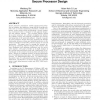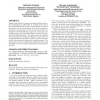264 search results - page 5 / 53 » Software Protection by Hardware and Obfuscation |
MICRO
2006
IEEE
14 years 1 months ago
2006
IEEE
Secure processor architecture enables tamper-proof protection on software that addresses many difficult security problems such as reverse-engineering prevention, trusted computing...
ACSC
2006
IEEE
14 years 1 months ago
2006
IEEE
Code obfuscation is a relatively new technique of software protection and it works by deterring reverse engineering attempts by malicious users of software. The objective of obfus...
DRM
2006
Springer
13 years 11 months ago
2006
Springer
Despite huge efforts by software providers, software protection mechanisms are still broken on a regular basis. Due to the current distribution model, an attack against one copy o...
IH
2005
Springer
14 years 1 months ago
2005
Springer
Software protection is an area of active research in which a variety of techniques have been developed to address the issue. Examples of such techniques are software watermarking, ...
WORM
2003
13 years 9 months ago
2003
This paper presents DOME, a host-based technique for detecting several general classes of malicious code in software executables. DOME uses static analysis to identify the locatio...


